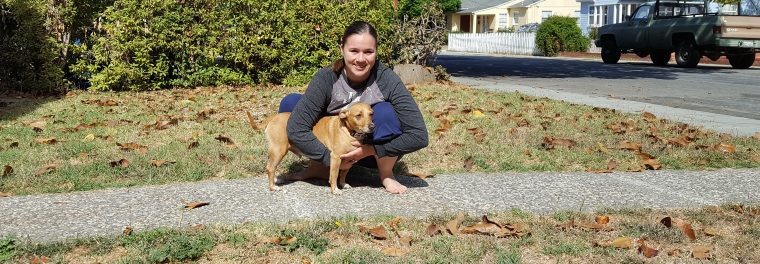The picture for this blog is of handsome Kody himself, and his devoted owner, Katee. As a pup, Kody was abandoned in a dumpster, along with his puppy brothers. As luck would have it, Katee soon came into Kody’s life and they became an inseparable pair. Fast forward to present day, Kody is now a 6 year old “corgi? lab? mix?”, as indicated on his client intake form. This past summer, Katee reached out to Skilled Mutts Company to explore what could be accomplished through dog training. Kody had developed fear-based behaviors and reactions over the years, and Katee’s goals were to improve the quality of his day-to-day life, as well as to find herself some relief from the additional anxieties that come with caring for an extremely sensitive dog.
Kody is a fearful dog, but he is also courageous.
He proved that when he transformed from a scaredy-dog to one who is more comfortable in his own fur. There’s no substitute for courage when squirming out of the hold of over-generalized fear. When I first met Kody, he introduced himself as a barking brown blur that leapt onto the couch to announce, “I’m a tough dog!” Just as quickly, the brown blur retreated to the floor while still reminding me that I was no match for it, and then snuck in a few sniffs while eyeing me suspiciously. I engaged Katee in conversation, and eventually she and Kody relaxed enough for me to sit down, say “Hi!”, and offer a hand shake (with Kody closely watching as he sat between us on the couch.)
Living with and caring for a fearful dog is not for everyone. Such a dog requires a patient and resilient human. Ultimately it was the habit of fear that I wanted to break – I worked with both Katee and Kody on exercises to build confidence, as well as on specific obedience cues that I wanted to integrate into the overall training plan. Katee diligently practiced with Kody, who has learned that he can trust his home environment. He has learned to find sanctuary in a crate and to interrupt his suspicious stares at people or things when asked to “leave it”. Every time a fearful dog engages in training, he is not just learning new cues or behaviors.
He is practicing courage with each session.
No matter how little or much courage a dog (or person) is born with, it is something that can always be grown, and that’s achieved through active practice. After knowing that Kody was abandoned in a dumpster, it’s hard not to get teary-eyed, but it’s worth noting that Kody is not just some poor, innocent victim of life’s circumstances. Kody is also smart, and like all smart dogs, he has figured out ways to indulge himself, such as jumping on the couch uninvited.
Me: “What do you normally do when he does that?”
Katee: “We tell him to get off or put him on the floor, but then he looks at us with this really sad face…We call it his shelter-face.”
Smart dogs make great trainers of humans.
We worked on this and good progress was made; until Kody discovered couch-tag.
Me: “I notice that he’s acting a bit differently than our last session.”
Katee: “Yeah, he now jumps on the couch and then hops from one to the other so we can’t catch him.”
As if he knew what we were talking about, Kody demonstrated his new skill to me. He deftly jumped onto the couch, then took a running leap off the armrest to the adjacent love seat, only he couldn’t quite make it. For a few harrowing seconds he was stretched out like a doggy suspension bridge, front claws barely holding onto the love seat, back toes straining to lift off the couch’s armrest, and belly outstretched across the chasm between furniture pieces.
Me: “I shouldn’t laugh…But we really need to stop that.”
Most people equate patience with waiting around for something to happen, or applicable just for times when we are forced to suffer and wait. But what if patience was not just about suppressing radioactive levels of I-am-hugely-annoyed?
Patience is something that is active; Not passive.
It’s persistence without acting out in frustration. Katee had invited her Mom to join us in a training session one day. We practiced telling Kody that space was a good thing, and that couch jumping was no longer the general rule of thumb.
Kody (if he could talk): “Surely, you jest!”
Katee and Mom remained united and after several rounds, Kody removed his shelter-face, remained on the floor and calmly sat down on his own.
Me: “It’s great! You’re both so patient.”
Katee and Mom (both snickering and rolling eyes): “Well…we’re patient with dogs.”
That was the summer; Let’s fast forward to autumn.
Me: “How is Kody doing?”
Katee: “Kody is amazing. He is more confident and is OK with giving me space now. He goes in his crate and allows me to [close the flap-door]. When he gets a little anxious he just goes into his crate on his own. I think he is finally finding it calming which is great.”
Both Kody and Katee have found relief from their past worries and have learned to inject predictability through simple rules in the home.
And all of it was possible without diminishing their bond.
Want Us to Fetch Doggy Bloggies For You?
Enter your email address to subscribe. You won’t get any spam, unless it’s a blog about a dog eating it.

